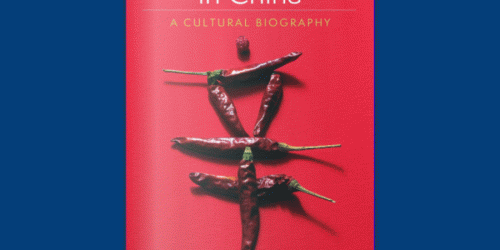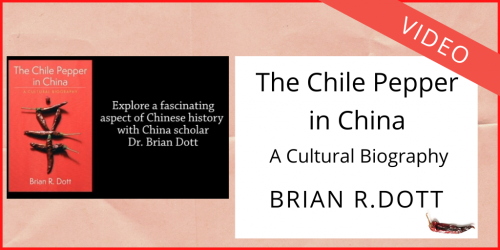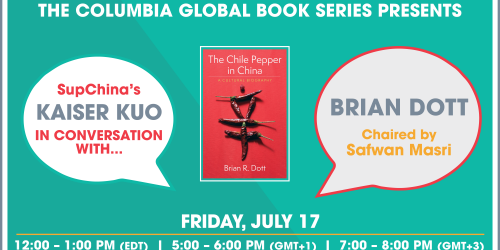Food as Medicine, Medicine as Food
By Brian R. Dott

“A learned as well as lively book with many surprises. How chile peppers came to China from the New World just starts a story involving taste, regionalism, adaptation, and folklore. Chiles were key to Chinese cuisine’s subtlety and variety, and not just in Sichuan and Hunan either.”
~Paul Freedman, author of Food: The History of Taste and Ten Restaurants That Changed America
This week’s featured book is The Chile Pepper in China: A Cultural Biography, by Brian R. Dott, Associate Professor of History and Asian & Middle Eastern Studies at Whitman College. Dott traces the chile pepper’s influence in Chinese cuisine, language, medicine, and other aspects of society. In today’s guest blog post, Dott gives a taste of his work by focusing on some medicinal uses of the chile in China’s history.
Enter this week’s drawing for a chance to win a copy of the book!
• • • • • •
Chinese food without chiles?! Seems unimaginable! Yet this crop from the Americas didn’t arrive in China until around 1570. Its use took off quickly. By 1621, one author described chiles as “growing everywhere,” and in the eighteenth century, another source proclaimed that they “are as indispensable in daily cuisine as onions and garlic.” Chiles were associated with the pungent, spicy role that native Sichuan peppercorn had filled, yet came to be more popular, widespread, and symbolic of spiciness in both food and temperament. Intriguingly, some famous dishes like Mapo Tofu show a marriage of the “la” spiciness of chiles with the numbing “ma” of the Sichuan peppercorn. The chile has become indelibly associated with certain regional cuisines in China, but still has a supporting role in others. An important factor in the popularization of chiles in China was its adaptability to regional conditions. Thus, Chinese from different regions adopted chiles for different purposes. Some of those purposes covered in my book, but not this blog, include art, literature, songs, revolutionary propaganda, and gender construction. The following playful rhyme and wordplay reflects recent differences of chile use between regions, as well as friendly competition:
Hunan people don’t fear spicy food.
Guizhou people spicy food don’t fear.
But, Sichuan people fear nonspicy food!
In recent years, there have been large, popular chile-eating contests with an emphasis on both quantity and high capsaicin content.
Soon after their introduction to China, chiles were used as a flavoring and were appreciated for their beauty in gardens—but their medicinal use also played a key role in their adoption and spread. For chiles to be fully integrated into Chinese cultural practices, they had to be categorized within long-lasting medical classification systems according to their pungency, spiciness, heating properties, and other traits. While these classifications seem obvious to anyone who has eaten spicy chiles, explicit labeling was key for both medicinal and culinary use. Within traditional Chinese medicine systems, there is no clear line between food and medicine. Whatever is taken into the body, whether as a flavoring, vegetable, or medicine, is understood to impact health.
Some of the medicinal uses of chiles paralleled those for other pungent plants, such as the native Sichuan peppercorn, ginger, or imported black pepper. These uses were associated with the health of the lungs and large intestine. In other cases, treatments arose from observed effects of consuming chiles as food or medicine. Here is a list of some Chinese medical uses of chiles from the 1600s into the early 1900s:
-
- aids digestion
- stimulates appetite
- cures food poisoning from seafood (especially coastal Fujian)
- warms the body
- also cools the body by inducing sweating
- helpful for drying out the respiratory system (one author described the chile’s ability to expel excess moisture from the diaphragm “as easy as making water from snow!”
- expels excess moisture or damp more generally (especially southern, inland regions, such as Sichuan and Hunan)
- treatment for hemorrhoids (taken orally!)
- treatment for malaria
- treatment for snakebites (as both an analgesic and an anti-inflammatory)!
In recent times, it has become quite rare for practitioners of traditional Chinese medicine to actually include chiles in their prescriptions, but it is common for people to include them in their diets for health reasons. For many people living in the chile-loving inland regions of Sichuan, Hunan, and Guizhou, eating chiles regularly (often daily) is seen as essential for healthy living in their damp and humid climates.
The long-standing Chinese understanding of the links between food and medicine meshes well with contemporary worldwide food movements that emphasize the importance of understanding and directly choosing what we are taking into our bodies as a necessary component of healthy living.








